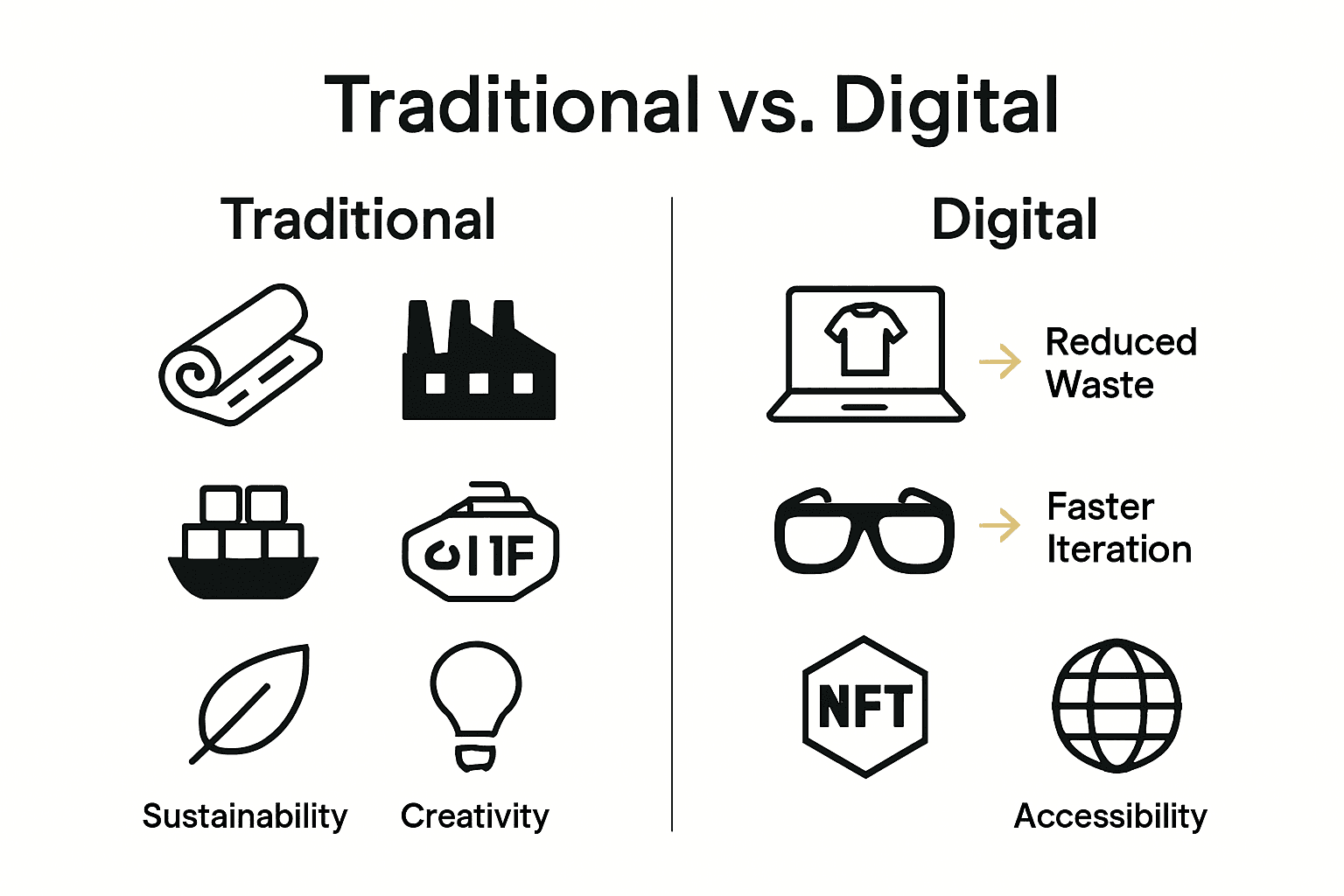Blog sidebar
Category
Recent Posts
- Dec 07, 2025
- Dec 05, 2025
- Dec 05, 2025
- Dec 02, 2025
- Dec 01, 2025
- Dec 01, 2025

Digital Fashion Explained: Key Concepts and Impact
Contents
Over 70 percent of fashion professionals believe digital design will shape the future of the industry. Digital fashion is rapidly changing the way people create, wear, and interact with clothing. With virtual garments, avatars, and NFTs becoming part of everyday conversations, understanding digital fashion’s roots and evolution can help you grasp why it matters and what makes it more than just a passing trend.
Table of Contents
- Defining Digital Fashion And Its Origins
- Types Of Digital Fashion: Clothing, Accessories, More
- How Digital Fashion Works: Technology And Platforms
- Uses, Benefits, And Sustainability In Digital Fashion
- Limitations, Legal Issues, And Common Concerns
Key Takeaways
| Point | Details |
|---|---|
| Revolutionary Intersection | Digital fashion merges technology with creative expression, allowing designers to create garments without physical constraints. |
| Diverse Applications | It encompasses various categories, including virtual clothing, augmented reality apparel, and fashion NFTs, broadening fashion’s scope. |
| Sustainability Benefits | Digital fashion significantly reduces environmental impact by minimizing material use and enabling virtual prototypes, enhancing sustainability. |
| Intellectual Property Issues | The sector faces challenges related to ownership rights and regulatory frameworks, necessitating clear guidelines for digital fashion products. |
Defining Digital Fashion and Its Origins
Digital fashion represents a groundbreaking intersection of technology and creative expression, where virtual design transcends traditional material constraints. According to ualresearchonline, it encompasses the virtual creation, production, and representation of identity through 3D virtual technologies.
At its core, digital fashion offers an entirely new realm of creative possibility. Atlantis Press highlights how this emerging field allows designers to explore aesthetics unrestricted by physical limitations, enabling the simulation of textures and effects impossible in traditional fashion design. This means creators can craft garments that defy gravity, materialise impossible colour gradients, and experiment with forms that would be structurally impractical in physical textiles.
Key characteristics of digital fashion include:
- Complete virtual design and rendering
- Ability to showcase clothing without physical production
- Potential for infinite creative experimentation
- Reduced environmental impact compared to traditional fashion manufacturing
The origins of digital fashion can be traced back to early 3D modelling techniques in gaming and animation industries, where virtual clothing and character design required increasingly sophisticated rendering technologies. As computer graphics advanced, fashion designers began recognising the potential to prototype, showcase, and even sell clothing exclusively in digital spaces. This evolution has accelerated with the rise of virtual reality, augmented reality, and metaverse platforms, transforming digital fashion from a niche concept to a rapidly growing industry segment.

While still emerging, digital fashion represents more than a technological trend—it’s a fundamental reimagining of how we conceptualise, create, and experience clothing in an increasingly digital world. As our guide on women’s clothing styles demonstrates, fashion continues to be a dynamic, ever-evolving form of personal and cultural expression.
Types of Digital Fashion: Clothing, Accessories, More
Digital fashion has emerged as a multifaceted domain with diverse applications that extend far beyond traditional clothing design. According to ualresearchonline, digital fashion encompasses six primary categories: digital skins for gamified environments, virtual influencer clothing, superimposed image-based garments, AR filter-based clothing, fashion NFTs, and digital twins.
Atlantis Press further elaborates that digital fashion blurs the boundaries between physical and virtual realms, creating innovative ways of experiencing and expressing personal style. This includes virtual garments for avatars, augmented reality clothing that overlays onto real-world images, and digital accessories that enhance virtual identities.
The main types of digital fashion include:
Here’s a summary of the main types of digital fashion and their characteristics:
| Type of Digital Fashion | Description | Example Usage |
|---|---|---|
| Virtual Clothing | Garments existing purely in digital form | Avatar outfits in gaming |
| Augmented Reality (AR) Apparel | Clothing superimposed on real images | AR filters on social media |
| Digital Accessories | Jewellery and bags in virtual space | Digital handbags for avatars |
| Gaming Skins | Custom outfits for digital characters | Skins in video games |
| Fashion NFTs | Unique, blockchain-verified collectibles | NFT-based digital wearables |
- Virtual Clothing: Garments designed exclusively for digital environments
- Augmented Reality (AR) Apparel: Clothing that can be superimposed on real images
- Digital Accessories: Jewellery, bags, and other items existing purely in digital spaces
- Gaming Skins: Customised outfits for digital characters
- Fashion NFTs: Unique digital fashion collectibles with blockchain verification
As fashion continues to evolve, understanding these digital categories becomes crucial.
When exploring the latest fashion innovations, our guide to fashion trends provides deeper insights into how technology is reshaping personal style and creative expression.
How Digital Fashion Works: Technology and Platforms
Digital fashion leverages cutting-edge technologies to transform how we conceptualise and experience clothing. According to ualresearchonline, the core mechanism involves integrating 3D virtual technologies with fashion design, utilizing advanced 3D CAD software to create virtual garments that can be previewed during design and sampling stages.
Atlantis Press highlights the transformative potential of integrative digital technologies, including AI, 3D printing, body scanning, augmented reality (AR), virtual reality (VR), wearable technology, and innovative biomaterials. These technologies enable designers to create, modify, and showcase designs digitally, dramatically reducing the need for physical prototypes and opening up unprecedented creative possibilities.
Key technological platforms and tools in digital fashion include:
- 3D Modeling Software: Allows precise virtual garment creation
- Augmented Reality (AR) Platforms: Enables virtual clothing try-ons
- Virtual Reality (VR) Environments: Creates immersive fashion experiences
- Blockchain Technologies: Supports NFT fashion collectibles
- AI Design Generators: Assists in creating unique clothing concepts
As technology continues to evolve, digital fashion platforms are becoming increasingly sophisticated. For those interested in exploring the latest technological innovations, our guide to wearable tech devices offers insights into how digital technologies are reshaping personal style and technological interaction.
Uses, Benefits, and Sustainability in Digital Fashion
Digital fashion represents a revolutionary approach to clothing and personal expression that extends far beyond traditional design paradigms. According to ualresearchonline, this innovative field serves multiple purposes, including enhancing product development through virtual previews during design stages and offering entirely digital fashion products that reduce material waste and environmental impact.
Atlantis Press emphasizes how digital fashion creates an engaging world of intangible creativity, allowing designers to experiment beyond conventional boundaries and generate novel aesthetic experiences that challenge traditional fashion limitations. This approach opens up unprecedented opportunities for self-expression and design innovation.
Key benefits of digital fashion include:

- Reduced Environmental Impact: Minimizes physical material consumption
- Creative Freedom: Enables design experiments impossible in physical fashion
- Cost-Effective Prototyping: Allows rapid design iterations without material waste
- Global Accessibility: Creates fashion experiences independent of physical limitations
- Personalisation: Offers unique digital identity expression
As the fashion industry continues to evolve, understanding sustainable practices becomes crucial. For those interested in exploring broader sustainable fashion concepts, our guide to circular fashion provides deeper insights into environmentally conscious design approaches.
Limitations, Legal Issues, and Common Concerns
Digital fashion emerges as an innovative field, but it is not without significant challenges and potential drawbacks. According to ualresearchonline, the sector currently struggles with fundamental issues such as the lack of standardized definitions, complex intellectual property concerns, and the absence of comprehensive regulatory frameworks governing digital fashion products.
Atlantis Press further highlights the critical legal and ethical questions surrounding digital fashion, emphasizing the complex landscape of design ownership and usage rights. The technology raises significant concerns about intellectual property protection, particularly when digital designs can be easily replicated or transformed across multiple platforms.
Key limitations and concerns in digital fashion include:
- Intellectual Property Challenges: Unclear ownership and reproduction rights
- Technological Accessibility: Potential exclusion of users without advanced devices
- Digital Divide: Unequal access to digital fashion experiences
- Technical Complexity: High learning curve for designers and consumers
- Authenticity Verification: Difficulties in proving originality of digital designs
As digital fashion continues to evolve, understanding these complex dynamics becomes essential. Those interested in exploring the nuanced world of fashion technology might find our fashion trends guide helpful in navigating these emerging challenges and opportunities.
Discover How Digital Fashion Inspires Your Everyday Style
Digital fashion redefines creativity, offering boundless new ways to express identity without the limits of physical garments. With challenges like intellectual property concerns and the need for accessible technology, it opens doors to innovative self-expression but also calls for thoughtful choices. Whether you seek sustainable alternatives or simply want to explore unique style, understanding this shift can empower your wardrobe decisions.
Bring the excitement of digital creativity into your daily life by exploring a wide range of fashion accessories and personal wellness gadgets designed to enhance your style and well-being. Act now to embrace modern trends with confidence and ease at Stomart where convenience meets variety. Ready to transform how you look and feel? Start your style journey today with our latest arrivals and stay ahead by keeping up with the fashion trends guide. Your next bold style move is just a click away.
Frequently Asked Questions
What is digital fashion?
Digital fashion is the virtual creation, production, and representation of clothing using 3D technologies, allowing for designs to exist without physical constraints.
What are the main types of digital fashion?
The main types of digital fashion include virtual clothing, augmented reality apparel, digital accessories, gaming skins, and fashion NFTs, each serving unique roles in digital environments.
How does digital fashion contribute to sustainability?
Digital fashion contributes to sustainability by minimizing physical material consumption, reducing waste from prototyping, and allowing for more efficient and creative design processes.
What technologies are used in digital fashion?
Key technologies in digital fashion include 3D modelling software, augmented reality (AR), virtual reality (VR), blockchain for fashion NFTs, and artificial intelligence (AI) design generators.
Recommended
- Guide to Women’s Clothing: Styles, Tips, and Trends - STOMART.CO.UK
- Fashion vs Style Explained - STOMART.CO.UK
- Fashion vs Style Explained - STOMART.CO.UK
- Choosing the Perfect Clothing Store - STOMART.CO.UK
- Digital Brand Identity Explained: Key Elements & Strategies - Chiko Shire | The Official Website of Chiko Shire
- 7 Top Digital Trends 2025 You Must Know for Growth
Share
YOU MAY ALSO LIKE
- Dec 07, 2025
- Dec 05, 2025
- Dec 05, 2025
- Dec 02, 2025
- Dec 01, 2025
- Dec 01, 2025
- Nov 30, 2025
- Nov 30, 2025
- Nov 29, 2025
- Nov 25, 2025
- Nov 24, 2025
- Nov 23, 2025
- Nov 22, 2025
- Nov 21, 2025
- Nov 21, 2025
- Nov 21, 2025
- Nov 21, 2025
- Nov 21, 2025
- Nov 21, 2025
- Nov 18, 2025
- Nov 18, 2025
- Nov 18, 2025
Category
Recent Posts
- Dec 07, 2025
- Dec 05, 2025
- Dec 05, 2025
- Dec 02, 2025
- Dec 01, 2025
- Dec 01, 2025



















































